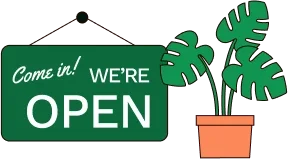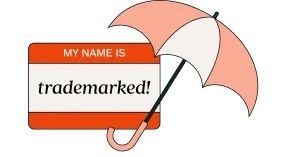If you have created intellectual property, establishing legal protections can help prevent others from using your assets without your permission. Intellectual property protections generally also give you the exclusive rights to profit from your creations.
While intellectual property can be tricky to understand, navigating it properly can mean the difference between waging a vicious court battle to protect your legal interests and quietly enjoying the fruits of your creative labors.
Copyrights and trademarks are two of the most frequently confused intellectual property rights. If you are in the business of creating unique goods for placement in the stream of commerce, it is essential that you understand the difference between the two.
Follow along to learn more about what each of these protections offer and how to apply for them.
Copyrights and trademarks defined
Copyrights and trademarks protect distinct creations. Although they're often confused, there are some major differences between a trademark and a copyright.
Generally, copyrights protect creative works like books, music, and movies, while trademarks protect the assets that businesses use to establish their identity in the marketplace, like brand names, slogans, and logos.
In fact, the two protections are so legally distinct that they are managed by two different offices within the federal government. Trademarks fall under the auspices of the U.S. Patent and Trademark Office (USPTO), while copyrights are granted by the U.S. Copyright Office.
What is a copyright?
Copyrights primarily protect the rights of people who create literary, dramatic, musical, artistic, and certain other original works (like history tests, and software code). According to the U.S. Copyright Office, copyrights are designed for "work in a tangible form of expression," which could range from photographs and musical compositions to computer programs, movies, architectural work, and more.
For example, The Walt Disney Company owns the copyrights to all the Star Wars movies; Paul McCartney owns the copyrights to the song "Hey Jude"; and Lin-Manuel Miranda owns the copyrights to the "Hamilton" play.
As soon as you create a work, you should immediately use the copyright symbol (the letter C with a circle around it, ©) to indicate that it is your intellectual property. Registering with the USCO solidifies and formalizes this fact.
What is a trademark?
While copyrights protect creative works, trademarks provide you with exclusive rights to specific words or symbols associated with your business. Trademarks can protect the use of a company's name and its product names, brand identity (like logos), and slogans.
Some popular examples of trademarks include McDonald's golden arches that form the letter M, Apple’s name and signature fruit logo, and Allstate's slogan, "You're in good hands."
Trademarks registered by the United States Patent and Trademark Office may feature the registered trademark symbol, which is the letter R with a circle around it (®).

What does a copyright protect?
While there are clearly some gray areas, copyright protections come down to one simple principle: copyright protects original works of authorship. This means names, ideas, concepts, and methods of operation are excluded from copyright protection.
In the U.S., copyright protection is specifically outlined in the Constitution. In Article I Section 8, commonly called the "Copyright Clause," the founding fathers formally recognized a group of rights protecting authors and their many forms of original expression.
Despite their intentions to protect creative works, their words left a great deal of the details up to interpretation. Since then, courts and lawmakers have attempted to clearly define the laws on copyright protection. In addition, scholars have dedicated many years and countless volumes to unraveling the complex web that has developed over the years.
So, where does this leave us today?
Copyright protection means that the copyright holder of the work retains exclusive rights to print, display, distribute, and perform their creative work. This includes the exclusive rights to publish and transmit the work on the internet. Copyrights generally last for the life of the author or creator of the material, plus 70 years.
What does a trademark protect?
Created by Congress in 1946, the legal protections of trademarks are much newer than copyrights. Although commonly viewed as protection for companies and their commercial interests, at the time they were legislated, trademarks were seen as protection for consumers as well.
In order to protect the interests of the buyer, a trademark prohibits the use of a known mark or brand by a person other than the trademark holder. The court also looks at whether or not a consumer is likely to be confused by the use of the brand or symbol.
This means that trademark protections extend to names, symbols, slogans, and even sounds and colors representing a company's brand identity. For instance, CBS trademarked the ticking stopwatch sound you hear during its "60 Minutes" series, while Mattel trademarked the color Barbie Pink, which is Pantone 219C. Therefore, other businesses cannot use that specific ticking sound or exact color without facing trademark infringement liability.
The 3 requirements of a copyright
Now, how do you know if your work is eligible for copyright protection? To qualify, the work must be original, creative, and tangible.
1. Originality
In order to warrant copyright protection, a work must be original. It cannot be a copy of another piece of work.
2. Creativity
There must be some element of creativity. While this can be subjective, the Supreme Court has explained that eligible material must exhibit at least a "spark" of creativity. In other words, it shouldn't be generic or common.
3. Fixation
A copyrighted work must be "fixed in a tangible medium of expression." While that may sound technical, it's important to understand.
Basically, the work must be established in some fixed form, such as a book, map, chart, print, dramatic work, sculpture, film, sound recording, or computer program. It cannot simply be an intangible idea.
The 3 requirements of a trademark
Trademarks must also meet certain criteria. They must be distinct, different from other trademarks, and used in commerce.
1. Distinctiveness
The mark must be distinguishable enough that consumers can associate it with your business as the source of the goods or services. It should be distinct and identifiable.
When measuring the distinctiveness of your mark, the trademark office recommends selecting something fanciful, arbitrary, or suggestive that is not descriptive or generic.
2. Uniqueness
The mark cannot conflict with already registered trademarks. If it's too similar to another brand's trademark, it may cause confusion among consumers, so the trademark office won't accept it.
3. Commercial use
Trademarks are designed to be used in commerce, so you must be using it in conjunction with your business or brand. You cannot trademark a name, symbol, or phrase simply because you want to protect it for personal use.

How to apply for a copyright
You must complete the copyright registration process when you have an original work you'd like to copyright. This involves submitting the appropriate information to the U.S. Copyright Office.
1. Meet required criteria
Before initiating the registration process, ensure that your creative work is eligible. As previously discussed, your work should be original, creative, and tangible.
When applying, you will agree that your creative works meet the eligibility requirements. If they don't, the office may refuse your application.
2. Navigate to the U.S. Copyright Office website
Next, visit the copyright office's website to access the registration portal. If you don't already have an account, create one with the Electronic Copyright Office (eCO) registration website.
3. Complete the application
Now you're ready to fill out the application. You'll provide information about your creative works, such as the title, author, and a description.
You can file up to 10 unpublished works on one application, but they must all fall within the same category. If they belong to different categories, you'll need to submit separate applications for each.
After completing the application, you'll pay the filing fee and submit a copy of the work.
The following are some examples of the filing fees:
- Electronic application for one work with one author—$45
- Electronic standard application for all other filings—$65
- Paper application—$125
4. Wait for approval
Once you've submitted your application, wait for the copyright office to review it.
They will either approve it and mail you a certificate of registration, or request additional information from you.
If you don't provide the requested information, the office may deny your request or place a hold on your application.
How to apply for a trademark
If you compare the registration process for a copyright vs. trademark, the trademark process is a little more involved.
The trademark registration process is thorough. U.S. Patent and Trademark attorneys are known to scrutinize applications closely, so you must meet all the criteria and follow the instructions.
Because it can be somewhat complicated, you may prefer to hire LegalZoom to complete the process for you to help ensure everything runs smoothly.
1. Check if your mark is eligible
Before filing an application with the USPTO, you must ensure that your mark qualifies for trademark protection. If you recall, this means selecting a distinct and unique mark for commercial uses.
2. Conduct a trademark search
An examining attorney determines if a proposed mark conflicts with current trademarks. Remember, you can't register a trademark that already exists.
If the mark is too similar to other marks, your application could get rejected. That's why it's important to run a trademark search to review already registered marks.
Searches ensure that a proposed trademark is sufficiently unique when compared to their federally approved trademarks. In fact, a thorough search can extend beyond the federal trademark database to include all 50 states, Canada, Europe, DBA filings and more. Consequently, a trademark search is a wise investment.
You can perform a search using the USPTO trademark search database or let LegalZoom conduct your search to help you avoid costly trademark conflicts.
3. Choose the right filing basis
Next, you must select the correct filing basis on your application.
If you're already using your trademark in commerce with your goods and services, pick the use-in-commerce filing basis.
However, if you have not used your trademark in commerce yet but plan to do so, choose the intent-to-use (ITU) filing basis. This gives you a grace period where you can secure your trademark before claiming use in commerce. That said, to complete the registration process, you must follow up by submitting an Amendment to Allege Use or a Statement of Use document.
4. Complete and submit your trademark application
Now that you have met the trademark requirements and selected the correct filing basis, you can create your USPTO account and submit your information.
The USPTO uses the Trademark Center as of Jan. 18, 2025. As part of the trademark registration process, you must select categories that describe what your trademark will protect.
When filing your application, you must include a clear description of your mark, provide a drawing of it, and select which classes of goods and services you plan to sell under the mark.
You'll also need to pay the base online application fee of $350 before submitting the application. There may be additional fees, such as if you are applying for more than one trademark or your application is incomplete. A list of trademark fees is provided by the USPTO.
5. Respond to any USPTO actions
The next step involves waiting for an attorney to review your application. If they approve it, they'll submit it for publication, but if they find issues with it, they'll send you an office action.
An office action is a letter that outlines one or more problems with your application and how to remedy them. Submit your revisions by the deadline, and the attorney will review them and either approve your application or send you a final office action with additional requests.
Alternatively, you can file an appeal with the Trademark Trial and Appeal Board (TTAB). If you win your appeal, the attorney will approve your application without requiring revisions.
If you don't resolve your issues by the deadlines, your application will be considered abandoned, and you'll need to take steps to revive it if you wish to proceed.
6. Maintain your trademark
Once your application is approved and your mark is officially registered, it's essential to maintain your trademark.
To keep your mark valid, you must file maintenance documents, including the "Declaration of Use under Section 8," due between the fifth and sixth year from your registration date, and the "Declaration of Use and Application for Renewal under Sections 8 and 9," due between the ninth and 10th year and every 10 years thereafter. If you fail to do so, your mark will lose its registered status.
We also encourage you to periodically conduct trademark searches to ensure that no one is using your mark or something similar without your permission.

What to do about infringement
Now, let's consider infringements. Let's say there's a playground in your community with statues of popular Disney characters. The sculptures are obvious representations of characters from Disney movies. They are also obviously done by a local artist without official permission to use the likenesses from Disney. In this case, has an infringement taken place?
To infringe a trademark or copyright, the infringer must trespass on what the intellectual property protects. The infringer must take a particular expression (like Snow White as a character from a film) or co-opt the goodwill built up by the company (Snow White as part of the Disney princess brand).
For the fiberglass statue in the park, the infringement is a bit of both. The playground is taking the decisions that Disney made when designing the characters. Even if the execution is less than perfect, reproducing Disney's character's look uses a critical part of the animated film without permission. Moreover, the way the playground uses the characters is closely aligned with how Disney uses its princesses.
The key legal question is whether the circumstances create confusion among consumers. This could involve a jury having to determine if the playground's use of Snow White might cause users to think that the playground is in some way associated with Disney. The fiberglass princesses may be a long way from Disneyland, but it may be reasonable to think that the maker of the statue or the park owner would have licensed rights from Disney to use its characters and trademarks.
How to address infringement
As you can imagine, determining copyright or trademark infringement can be a complicated and somewhat convoluted process.
That said, if you believe someone has infringed upon your exclusive rights, we encourage you to consult an attorney specializing in trademark and copyright law. They can help determine if someone violated your rights and what next steps to take. This might involve sending a cease-and-desist letter and taking legal action.
FAQs
Is it better to have a copyright or trademark?
One is not better than the other, as each has its own distinct purpose. In short, copyrights are for creative works, while trademarks are for names, slogans, and symbols associated with a brand.
Therefore, in some cases, you may need both to protect your business’ branding and its creations. For example, if you run an art business, you might trademark your brand logo and company name and copyright your original artwork.
How much does a copyright cost?
When applying for a copyright, you must pay the associated filing fees, which depend on the works you register and how you file.
An electronic single application for one work with one author costs $45, while an electronic standard application for all other filings (such as multiple works by multiple authors) is $65. If you choose to mail in your application, the fee is $125.
How much does a trademark cost?
The cost of registering a trademark depends on which application you select and how many classes you register.
The USPTO charges a base application fee of $350 per class of goods or services for all applications filed through the Trademark Center. The USPTO provides a list of trademark fees. If you hire a service like LegalZoom to run a comprehensive trademark search, packages start at $199.
Can trademarks and copyrights be rejected?
Yes, trademarks and copyrights can be rejected if they don't meet the eligibility requirements. The respective offices will contact you for additional information or changes in these cases. If you comply with the requests, then your application should be back on a path towards approval.
How long do trademarks and copyrights last?
To keep your trademark valid, you must file the appropriate maintenance documents. You need to file a "Declaration of Use under Section 8" between the fifth and sixth year from your registration date, while a "Declaration of Use and Application for Renewal under Sections 8 and 9" is due between the ninth and tenth year (and again every 10 years). If you fail to submit these documents, your trademark will be considered “abandoned,” and you will lose your exclusive rights.
As for copyrights, they remain active for the duration of the author's life plus an additional 70 years. After that, the works enter the public domain.
Corie Lynn Rosen contributed to this article.



